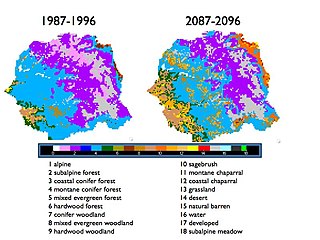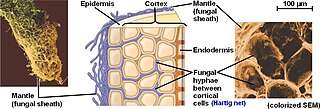
The carbon cycle is that part of the biogeochemical cycle by which carbon is exchanged among the biosphere, pedosphere, geosphere, hydrosphere, and atmosphere of Earth. Other major biogeochemical cycles include the nitrogen cycle and the water cycle. Carbon is the main component of biological compounds as well as a major component of many minerals such as limestone. The carbon cycle comprises a sequence of events that are key to making Earth capable of sustaining life. It describes the movement of carbon as it is recycled and reused throughout the biosphere, as well as long-term processes of carbon sequestration (storage) to and release from carbon sinks.

Numerical climate models use quantitative methods to simulate the interactions of the important drivers of climate, including atmosphere, oceans, land surface and ice. They are used for a variety of purposes from study of the dynamics of the climate system to projections of future climate. Climate models may also be qualitative models and also narratives, largely descriptive, of possible futures.

A general circulation model (GCM) is a type of climate model. It employs a mathematical model of the general circulation of a planetary atmosphere or ocean. It uses the Navier–Stokes equations on a rotating sphere with thermodynamic terms for various energy sources. These equations are the basis for computer programs used to simulate the Earth's atmosphere or oceans. Atmospheric and oceanic GCMs are key components along with sea ice and land-surface components.

The Gaia hypothesis, also known as the Gaia theory, Gaia paradigm, or the Gaia principle, proposes that living organisms interact with their inorganic surroundings on Earth to form a synergistic and self-regulating, complex system that helps to maintain and perpetuate the conditions for life on the planet.
The Carl-Gustaf Rossby Research Medal is the highest award for atmospheric science of the American Meteorological Society. It is presented to individual scientists, who receive a medal. Named in honor of meteorology and oceanography pioneer Carl-Gustaf Rossby, who was also its second (1953) recipient.
The Community Climate System Model (CCSM) is a coupled general circulation model (GCM) developed by the University Corporation for Atmospheric Research (UCAR) with funding from the National Science Foundation (NSF), the Department of Energy (DoE), and the National Aeronautics and Space Administration (NASA). The coupled components include an atmospheric model, a land-surface model, an ocean model, and a sea ice model. CCSM is maintained by the National Center for Atmospheric Research (NCAR).
Downscaling is any procedure to infer high-resolution information from low-resolution variables. This technique is based on dynamical or statistical approaches commonly used in several disciplines, especially meteorology, climatology and remote sensing. The term downscaling usually refers to an increase in spatial resolution, but it is often also used for temporal resolution. This is not to be confused with image downscaling which is a process of reducing an image from a higher resolution to a lower resolution.

Syukuro "Suki" Manabe is a Japanese–American meteorologist and climatologist who pioneered the use of computers to simulate global climate change and natural climate variations. He was awarded the 2021 Nobel Prize in Physics jointly with Klaus Hasselmann and Giorgio Parisi, for his contributions to the physical modeling of earth's climate, quantifying its variability, and predictions of climate change.
Land surface models (LSMs) use quantitative methods to simulate the exchange of water and energy fluxes at the Earth surface–atmosphere interface. They are key component of climate models. Over the past two decades, they have evolved from oversimplified schemes, which described the surface boundary conditions for general circulation models (GCMs), to complex models that can be used alone or as part of GCMs to investigate the biogeochemical, hydrological, and energy cycles at the earth's surface.
IBIS-2 is the version 2 of the land-surface model Integrated Biosphere Simulator (IBIS), which includes several major improvements and additions to the prototype model developed by Foley et al. [1996]. IBIS was designed to explicitly link land surface and hydrological processes, terrestrial biogeochemical cycles, and vegetation dynamics within a single physically consistent framework

Polar amplification is the phenomenon that any change in the net radiation balance tends to produce a larger change in temperature near the poles than in the planetary average. This is commonly referred to as the ratio of polar warming to tropical warming. On a planet with an atmosphere that can restrict emission of longwave radiation to space, surface temperatures will be warmer than a simple planetary equilibrium temperature calculation would predict. Where the atmosphere or an extensive ocean is able to transport heat polewards, the poles will be warmer and equatorial regions cooler than their local net radiation balances would predict. The poles will experience the most cooling when the global-mean temperature is lower relative to a reference climate; alternatively, the poles will experience the greatest warming when the global-mean temperature is higher.

A Dynamic Global Vegetation Model (DGVM) is a computer program that simulates shifts in potential vegetation and its associated biogeochemical and hydrological cycles as a response to shifts in climate. DGVMs use time series of climate data and, given constraints of latitude, topography, and soil characteristics, simulate monthly or daily dynamics of ecosystem processes. DGVMs are used most often to simulate the effects of future climate change on natural vegetation and its carbon and water cycles.

The carbonate–silicate geochemical cycle, also known as the inorganic carbon cycle, describes the long-term transformation of silicate rocks to carbonate rocks by weathering and sedimentation, and the transformation of carbonate rocks back into silicate rocks by metamorphism and volcanism. Carbon dioxide is removed from the atmosphere during burial of weathered minerals and returned to the atmosphere through volcanism. On million-year time scales, the carbonate-silicate cycle is a key factor in controlling Earth's climate because it regulates carbon dioxide levels and therefore global temperature.
ECHAM is a general circulation model (GCM) developed by the Max Planck Institute for Meteorology, one of the research organisations of the Max Planck Society. It was created by modifying global forecast models developed by ECMWF to be used for climate research. The model was given its name as a combination of its origin and the place of development of its parameterisation package, Hamburg. The default configuration of the model resolves the atmosphere up to 10 hPa, but it can be reconfigured to 0.01 hPa for use in studying the stratosphere and lower mesosphere.

The Hartig net is the network of inward-growing hyphae, that extends into the plant host root, penetrating between plant cells in the root epidermis and cortex in ectomycorrhizal symbiosis. This network is the internal component of fungal morphology in ectomycorrhizal symbiotic structures formed with host plant roots, in addition to a hyphal mantle or sheath on the root surface, and extramatrical mycelium extending from the mantle into the surrounding soil. The Hartig net is the site of mutualistic resource exchange between the fungus and the host plant. Essential nutrients for plant growth are acquired from the soil by exploration and foraging of the extramatrical mycelium, then transported through the hyphal network across the mantle and into the Hartig net, where they are released by the fungi into the root apoplastic space for uptake by the plant. The hyphae in the Hartig net acquire sugars from the plant root, which are transported to the external mycelium to provide a carbon source to sustain fungal growth.
Michael Ghil is an American and European mathematician and physicist, focusing on the climate sciences and their interdisciplinary aspects. He is a founder of theoretical climate dynamics, as well as of advanced data assimilation methodology. He has systematically applied dynamical systems theory to planetary-scale flows, both atmospheric and oceanic. Ghil has used these methods to proceed from simple flows with high temporal regularity and spatial symmetry to the observed flows, with their complex behavior in space and time. His studies of climate variability on many time scales have used a full hierarchy of models, from the simplest ‘toy’ models all the way to atmospheric, oceanic and coupled general circulation models. Recently, Ghil has also worked on modeling and data analysis in population dynamics, macroeconomics, and the climate–economy–biosphere system.
Global terrestrial stilling is the decrease of wind speed observed near the Earth's surface over the last three decades, originally termed "stilling". This slowdown of near-surface terrestrial winds has mainly affected mid-latitude regions of both hemispheres, with a global average reduction of −0.140 m s−1 dec−1 or between 5 and 15% over the past 50 years. With high-latitude showing increases in both hemispheres. In contrast to the observed weakening of winds over continental surfaces, winds have tended to strengthen over ocean regions. In the last few years, a break in this terrestrial decrease of wind speed has been detected suggesting a recovery at global scales since 2013.
Earth systems models of intermediate complexity (EMICs) form an important class of climate models, primarily used to investigate the earth's systems on long timescales or at reduced computational cost. This is mostly achieved through operation at lower temporal and spatial resolution than more comprehensive general circulation models (GCMs). Due to the nonlinear relationship between spatial resolution and model run-speed, modest reductions in resolution can lead to large improvements in model run-speed. This has historically allowed the inclusion of previously unincorporated earth-systems such as ice sheets and carbon cycle feedbacks. These benefits are conventionally understood to come at the cost of some model accuracy. However, the degree to which higher resolution models improve accuracy rather than simply precision is contested.
A fine root is most commonly defined as a plant root that is two millimeters or less in diameter. Fine roots may function in acquisition of soil resources and/or resource transport, making them functionally most analogous to the leaves and twigs in a plant's shoot system. Fine-root traits are variable between species and responsive to environmental conditions. Consequently, fine roots are studied to characterize the resource acquisition strategies and competitive ability of plant species. Categories of fine roots have been developed based on root diameter, position in a root system's branching hierarchy, and primary function. Fine roots are often associated with symbiotic fungi and play a role in many ecosystem processes like nutrient cycles and soil reinforcement.
Ocean dynamical thermostat is a physical mechanism through which changes in the mean radiative forcing influence the gradients of sea surface temperatures in the Pacific Ocean and the strength of the Walker circulation. Increased radiative forcing (warming) is more effective in the western Pacific than in the eastern where the upwelling of cold water masses damps the temperature change. This increases the east-west temperature gradient and strengthens the Walker circulation. Decreased radiative forcing (cooling) has the opposite effect.









